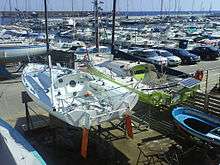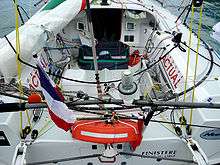Mini Transat 6.50
| Founded | 1977 |
|---|---|
| Classes | Classe Mini proto, Classe Mini série |
| Start | Douarnenez |
| Finish | Pointe-à-Pitre |
| Type | single-handed offshore race |
| Length | 4,020 nautical miles (7,450 km; 4,630 mi) |
| No. of competitors | 72 (2015) |
| Most recent champion(s) |
Benoît Marie (proto) Aymeric Belloir (série) |
| Official website |
minitransat-ilesdeguadeloupe |
Mini Transat 6.50 also known as Transat 650 is a solo transatlantic yacht race, and associated Classe Mini class, that (typically) starts in France and ends in Brazil covering over 4,000 miles with a stop in the Madeira or the Canary Islands. The yachts are very small considering the scope of the race, and are sanctioned by the Miniclasse 6.5 organization and material specifications, which make the mini Transat 650 boat an open design.[1]
The race runs on odd-numbered years, and was most recently completed in 2015. Sailors had to qualify by covering one of two specified 1,000 mile courses along with having 1,000 miles of ocean racing experience, much of it solo.

6.50 Class

For its intended use, racing across the Atlantic Ocean, the Mini 6.50 is very short and beamy, being nearly half as wide as it is long. Its width carries to the stern, providing sufficient stability that the boats can plane as a fast motorboat does: Minis are capable of sailing as fast as 25 knots. They typically have two connected rudders and a narrow steel or iron fin keel with a lead bulb at the end, with a mast height typically twice the Mini's length. They also have a retractable bowsprit that extends a spinnaker-genoa "kite" two or more meters beyond the bow. Minis must be self-righting when capsized, and this is tested by pushing the end of the mast under water with the vessel's hatches open; this design avoids the possibility of turtling.
There are two divisions: production and prototype. Production boats use approved designs and comparatively conservative materials.[2] The prototype division is more liberal with respect to dimensions, such as keel depth and mast height, and it allows for advanced technology such as "canting" keels and carbon-fibre masts. The prototype class is approximately 7% faster.
By far, the most successful mini design is the commercially produced Pogo 2 designed by Jean-Marie Finot of Groupe Finot (now Finot-Conq) in 1995. In 2010, California's Open Sailing USA[3] began building the Pogo 2, under license, giving hope for substantial mini racing in the Western Hemisphere. Though considered "accessible" as an ocean racing class, a used Pogo 2 costs upwards of $97,000.
Race culture
There are no prizes and the Mini Transat is not necessarily considered a race for the win. Sailors are competitive yet mutually-supportive during training and preparations, they tend to be closely grouped during the race, and a race completion is seen as a personal or national victory that comes with intangible rewards. Non-completion means, at very least, loss of the mini. The race is considered dangerous and there was a drowning during the first leg of the 2009 race. Racers typically sleep only 20 minutes at a time and rely on computerized autopilot systems to keep the craft on course while they sleep. The class is considered an incubator for professional ocean racing as a proving ground for sailing skills, as well as a test platform for larger ocean classes such as the Open 60.
Other than the single-handed transatlantic crossing, there are a good many other races held for the class. In-between years see double-handed events, such as the Mini Fastnet, Mini Barcelona, Select 650 and Open Demi-Cle. The Transat years incorporate more single-handed events.
History
Bob Salmon developed the idea of a mini-transatlantic race in the late 1970s in England with the intent of promoting affordable offshore solo racing. It was partially conceived as a response to the trend for bigger and more expensive boats such as sailed in the OSTAR race that seemed to exclude ocean racing for sailors with moderate budgets.
The first Mini Transat started from the Penzance Sailing Club in 1977 and races have since run bi-annually on odd numbered years. There was a move to Brest, France in 1985, and since then, it has started at various locations in France, such as Brittany, La Rochelle or Charente-Maritime, with a stop in the Canary Islands or Madeira ending in the West Indies or Brazil.
Criticism
The race is described as "mad" as the individual isolation causes predicable problems in combination with the hazards of solo ocean travel in small high-performance sailing vessels. In response, Classemini has created rigorous trials, equipment, and inspection requirements to add sanity to the race. Also, it might be said that the division within the class, production vs. prototype, unnecessarily divides the race. The mini Transat remains a largely French race with only about 30% non-French racers.
Another criticism is that the race is admitted to be a "test bed" for mechanisms to be used on bigger and far more expensive open classes. Reason for concern is that the race is potentially so dangerous, with one racer drowning in 2009, and many more in the past. On the other hand, David Raison's Mini introduces a whole new hull shape with its 2011 victory, which may, in fact, revolutionize open ocean racing if not sailing altogether[4][upper-alpha 1]; and the 2011 race suffered no casualties.
References
Notes
- ↑ The Magnum begat an even more radical 'semi-flying' scow that uses a host of design tricks, including wings/foils and a telescopic canting keel, a retractable bowsprit and an Asymmetrical spinnaker, has been designed in France.[5]
Citations
- ↑ "Miniclasse 6.5 organization". The Miniclasse 6.50 closely monitors the craft but applies minimal design restrictions, such as length (6.5m), beam (3.0m), draft (approximately 2.0m)"Mini 6.50 class rules".
- ↑ "Class Rules".
- ↑ "Open Sailing USA".
- ↑ Raison, David (November 18, 2010). "Vidéo à la Hune" (Video) (in French). Retrieved March 5, 2016.
- ↑ Boyd, James (September 19, 2015). "The semi-flying Mini scow". The Daily Sail. France. Retrieved March 5, 2016.
We look at Simon Koster's new weapon, penned by Michel Desjoyeaux's design firm Mer Forte
External links
| Wikimedia Commons has media related to Mini 6.50. |
- Official website
- Mini Transat on the Classe Mini website (French)
